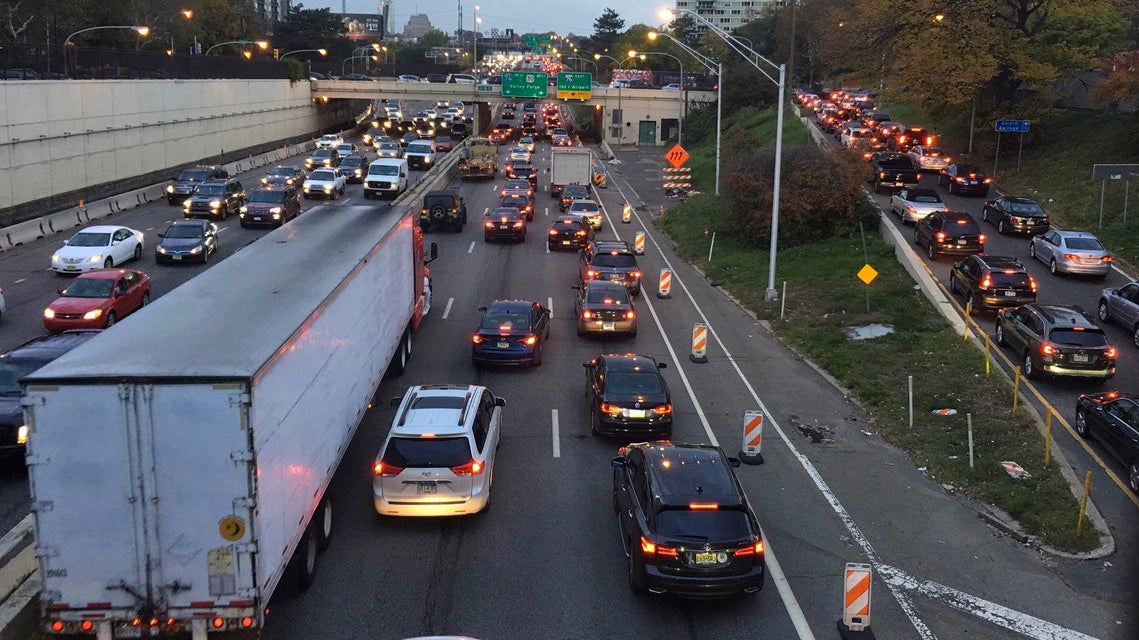As congestion worsens in Philly, car-related emissions spike
Philadelphia’s congestion problem is growing on the streets and in the air.

Traffic clogs I-676 in Philadelphia during the SEPTA strike. (Katherine Blodgett via Twitter)
Philadelphia’s congestion problem is growing on the streets and in the air.
Data from Boston University revealed that transportation emissions in the Philadelphia region increased by 22% between 1990 and 2017. That’s 9% per person when broken down per capita.
Transportation emissions are the biggest source of greenhouse gas in the United States, according to the most recent data from the EPA. But in Philadelphia, buildings and industry make up 79% of carbon emissions, while transportation only accounts for 17%.
Still, Rich Freeh, senior project manager for the city’s Office of Sustainability, says “we need to do better, even though it is a relatively small part of the pie compared to the overall carbon footprint.”
Freeh pointed to CONNECT, a strategic transportation plan designed to lower emissions — to reduce congestion on city streets.
City officials are working to reduce Philadelphia’s carbon footprint by 28% in about five years as part of the Kenney administration’s larger effort to reduce greenhouse gases by 80% by 2050. The solution for reducing traffic congestion looks a lot like the fix for emissions, experts say.
“Really, the more that we can push people towards public transportation, biking and walking, that’s going to be the single biggest chunk out of that emissions slice that we can take,” said Nick Zuwiala-Rogers, transportation program director for Clean Air Council.
The city is working to increase those modes by 5% by 2025.
Zuwiala-Rogers also voiced some skepticism about the city’s emissions numbers. He said the power grid and electric emissions “don’t necessarily happen where the building footprint is,” but “where that car is, where the tailpipe is, is where the pollution is happening.”
“There is a really localized part of the equation that needs to be considered particularly for the health impacts on communities that that has,” he said.
The city is also looking to achieve its sustainability goals by working with SEPTA. The authority is in its third year of a five-year procurement of hybrid buses, which ought to account for 95% of its fleet.
The transportation authority is also experimenting with electric buses in South Philadelphia along the 17 and 29 bus routes.
SEPTA also expects to get 10 more electric buses next year at Midvale Station in North Philadelphia. Such innovations are why SEPTA boasts about having the largest zero-emission bus fleet on the East Coast.
Another boost to air quality could come with the closure of the Philadelphia Energy Solutions complex. The refinery, which was shut down after a massive explosion this summer, was the city’s biggest polluter.
The 1,300-acre refinery produced just over 25% of the fuel consumed on the East Coast in a neighborhood with one of the highest asthma hospitalization rates in the city.
Recently, Mayor Jim Kenney and city officials traveled to Denmark to discuss climate change and sustainability with city leaders from around the world.
Upon Kenney’s return, the city will begin the Climate Change Collaborative of Greater Philadelphia, which will entail a partnership between local organizations to work toward sustainability.
WHYY is your source for fact-based, in-depth journalism and information. As a nonprofit organization, we rely on financial support from readers like you. Please give today.







